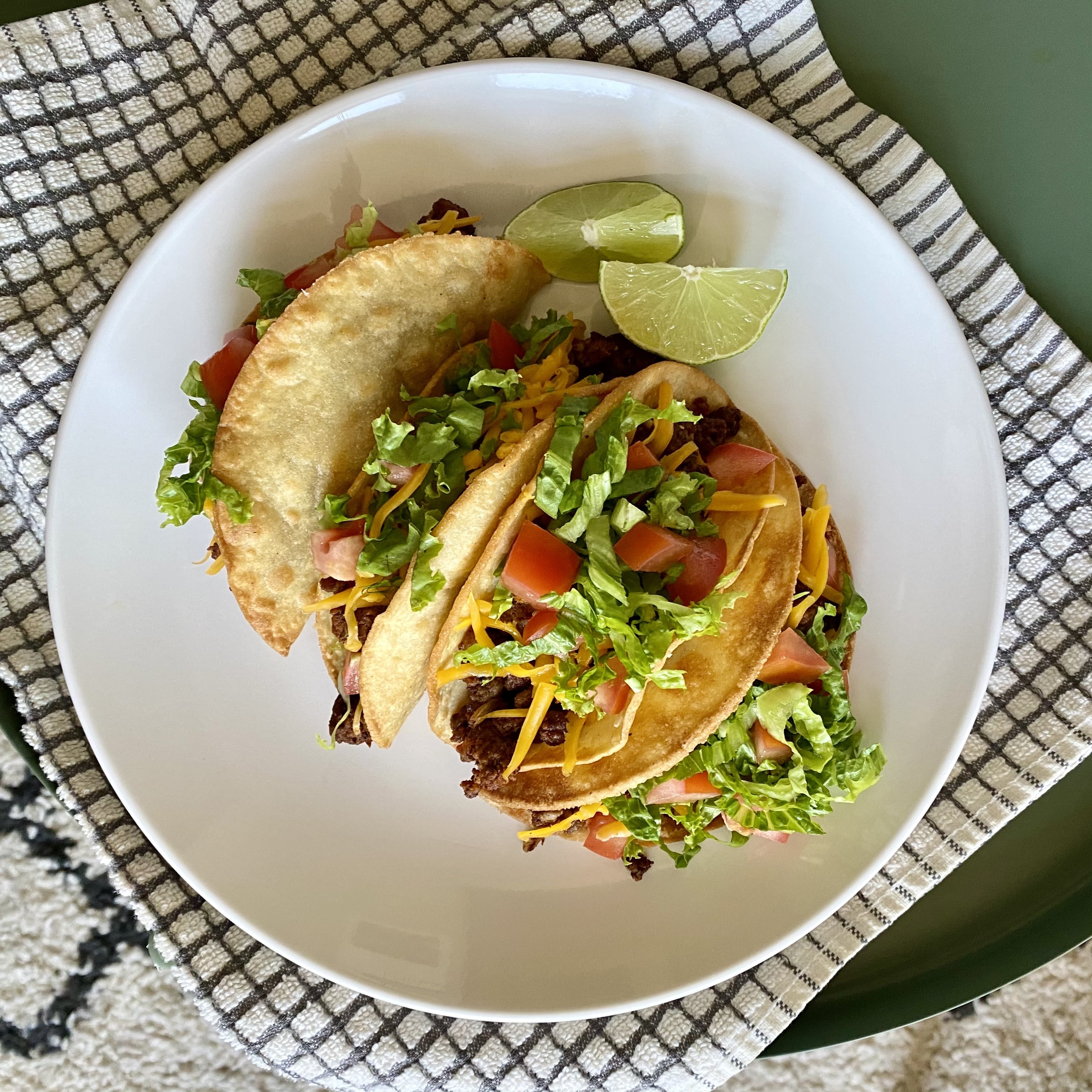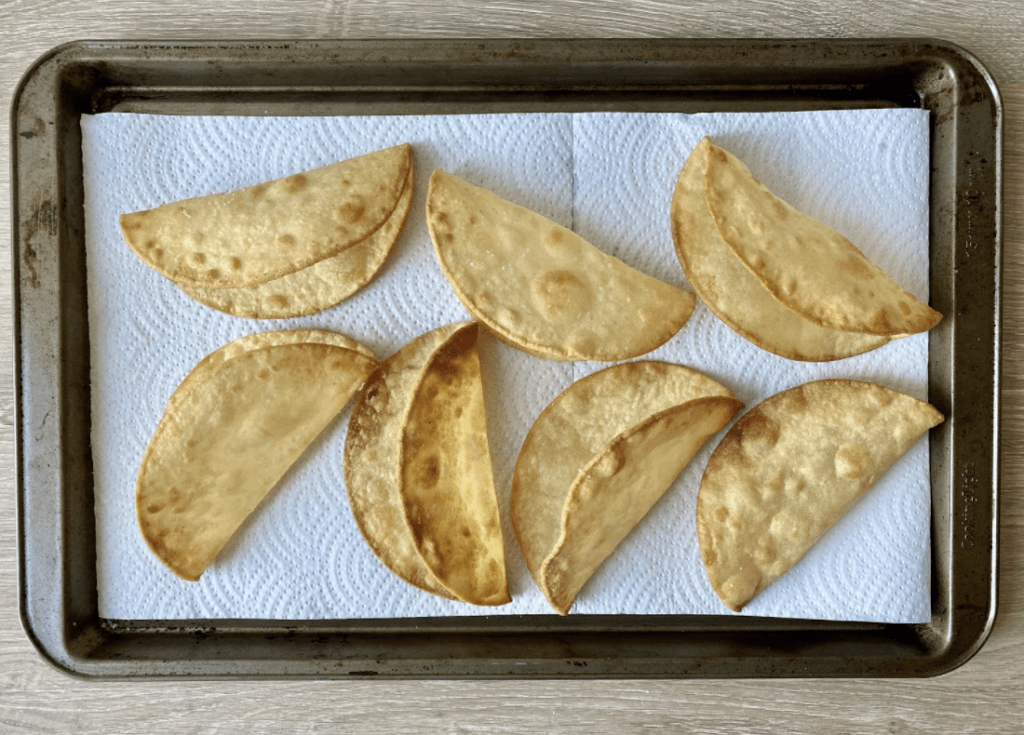
Historias de la Cocina: Hard Shell Tacos
This Mexican-American dish has a rich history of exploitation and reclamation.
We’re in the middle of Latinx Heritage Month, and this time of year always has me considering my Latinidad a little bit more thoughtfully than usual. I’ve started to think a lot about how, for many Mexican people in the United States, our food culture has evolved — and is invariably tied to this country. Mexican influences appeared on a national scale with the introduction of Mexican-American fast food chains like Chipotle and Taco Bell. There are also entire regional cuisines like Tex-Mex, New Mexican, and Baja Californian food that have evolved from more traditional Mexican roots to mix with American tastes, indigenous influences and local ingredients.
One meal that I’ve always considered distinctly Mexican-American is the hard shell taco. A crunchy fried corn tortilla shell is used as a vehicle for chili powder-spiced ground beef, shredded cheese, lettuce and tomato and is one of the most discredited Mexican-American dishes. I’ve seen many iterations of this dish, from the pre-made Old El Paso taco shell at “taco nights” I had at white friends’ houses to the Taco Bell Doritos Locos Taco that should have never been made. Tacos have been a trendy food, the subject of early memes and a fashion trend all within the past decade. A mid-2000s pop-culture craze had everything plastered with illustrated tacos and taco puns (remember the Forever 21 Taco Bell collab?). And while some are quick to dismiss hard-shell tacos as un-Mexican, I’ve come to recognize that the hard shell taco holds an exceptional space in Mexican-American food history, as something exploited by American fast food and then reclaimed by Mexican cuisine.
Hard shell tacos, as they exist today, are a testament to the evolution of authentic Mexican food and the development of Mexican-American cuisine. Jeffrey M. Pilcher, professor of history at the University of Minnesota and taco history expert notes that “a lot of Mexican American tacos are really adaptations of Mexican food to the ingredients that are available through the U.S. food-processing industry.” In Mexican American food history, as Pilcher points out, we see hamburger meat replacing offal meat and ingredients like cheddar cheese and iceberg lettuce being more and more incorporated into the Mexican-American diet.
Tacos are said to have originated from Mexican silver mines in the 18th century, with the first mention of them in the United States recorded in a newspaper in 1905. The crispy, hard shell version is likely an adaptation of Tacos dorados, an authentic Northern Mexican food. They are assembled with soft corn tortillas, filled with ground meat and pinched or rolled shut and fried until crisp. Hard shell tacos as they exist today, with an open-top fried shell were created by Mexican-American restaurateurs. According to Pilcher, the original patents for preformed taco shells were awarded to Mexican restaurant owners in the 1940s. Despite this history, Glenn Bell, the founder of Taco Bell, is largely credited with the creation of hard shell tacos. Taco Bell, a white-owned company, took a Northern Mexican dish and the idea of Mexican restaurateurs to create pre-formed shells, and exploited them both for profit. The chain restaurant also disrupted the history of the hard shell taco by taking credit for its creation, when in actuality hard shell tacos have roots in regional Mexican cuisine and Mexican-American restaurants.
Taco Bell’s problematic nature comes from more than just their exploitation of Mexican-American cuisine, their chemically-green Baja Blast and the mystery meat. From the inception of the chain, it was never founder Glen Bell’s intent to sell Mexican food to Mexican people. According to Professor Pilcher’s research, none of Taco Bell’s original franchises were located in predominantly Mexican neighborhoods though the chain was founded in Southern California, which is home to numerous areas with large Mexican populations. Instead, as Pilcher puts it, Bell sought to allow “Americans of other racial and ethnic groups to sample Mexican food without actually going in to Mexican neighborhoods.” The white man-founded taco chain wanted to serve Mexican-American food, but not be associated with Mexican-American communities.
This exploitation of Mexican food influences has changed Mexican-American food forever, but it’s not the end of the hard shell taco story. Once the crispy taco reached huge popularity due to Taco Bell’s far reaching franchise system, Tex-Mex restaurants began making their own pre-formed taco shells as well, by clipping the tortillas to bent coffee cans and frying them. From there, crispy-shelled tacos expanded everywhere. They showed up on the menus at Mexican restaurants nationwide, including my family’s own favorite haunts: a reclamation of a dish from those who exploited it for fast-food.
I grew up eating hard shell tacos as well as the more traditional taqueria-style tacos with soft corn tortillas. My abuela loves hard shell tacos with chicken, while my mom frequently made them with ground beef, shredded yellow cheese and lettuce and tomato. My family ate hard shell tacos for dinner almost as often as we had carne asada. Mama would cook a big skillet of ground beef, seasoned with garlic, onions, cumin and chile powder. Abuela would fry the shells, one at a time, folding them at just the right angle to fit all the fillings in before letting the oil drip off on a paper towel. We ate them so much that Mama developed her own way of eating them, with Tapatío hot sauce added on top of the meat and cheese but before any other toppings. “I don’t need my lettuce to be spicy,” she used to tell me.
Hard shell tacos were so instrumental to our family, that my younger sister even had a children’s book called “Mud Tacos,” which my mom read to her almost every night. The story details how the kids in the book make mud tacos to replicate their abuela’s hard shell “crispy, crunchy, spicy tacos” before eating actual tacos for dinner at the end. If anything, “Mud Tacos” showed me that hard shell tacos are pivotal to many families’ Mexican-American experience.
That experience often comes with homemade taco shells. I don’t think pre-made taco shells have ever been in my grandparents or my mom’s home. Frankly, I think store-bought shells give hard shell tacos a bad name. They are almost always stale and will never give the same mouthwateringly fatty effect that homemade taco shells do. If you take one piece of advice from me, let it be this: fry your own taco shells.

Photo of fried taco shells by author.
I made hard shell tacos for my partner for the first time a few weeks ago. We try to do taco Tuesday nearly every week, as a good excuse for me to cook Mexican food. I hadn’t eaten hard shell tacos myself for quite some time; a few years of avoiding cooking fried foods in the name of health had caused me to drift away from the shatteringly crispy homemade taco shells. Ground beef, shredded yellow cheese, shredded lettuce and chopped tomatoes made up our tacos. I always top off with Tapatío hot sauce (but then again, there are few things I won’t put Tapatio on) and serve with arroz y frijoles. Upon his first bite, my partner looked at me and told me, “This is everything Taco Bell was trying to be.”
He’s not wrong. The main components of a Taco Bell taco are all there. And while I will never condone eating from Taco Bell, the concept of a classic hard shell taco can be made into a delicious meal when executed correctly. The recipe is simple, and the toppings are easily accessible. The ground beef can easily be swapped for ground turkey, chicken or a vegan meat substitute. The only thing that is non-negotiable is frying your own taco shells. It is every bit worth the effort.
Hard Shell Tacos
Yield: 6 tacos
Time: 30 minutes
Ingredients
- ½ cup plus 1 tbsp. neutral cooking oil (canola or vegetable)
- 1 tsp. ground ground beef, 80/20 fat
- ¼ cup yellow or white onion, finely chopped
- 2 cloves garlic, minced
- 3 tsp. red chili powder
- ½ tsp. cumin
- 1 tsp. oregano (preferably Mexican)
- 1 tsp. plus a pinch of salt
- 6 corn tortillas
- ½ cup shredded cheese
- 1 cup shredded lettuce
- 2-3 tomatoes, diced
- Hot sauce (Tapatío, preferably) for topping (optional, but highly recommended)
- Mexican crema or sour cream for topping (optional)
Preparation
Step 1
Heat 1 tbsp. oil in a large skillet over medium heat. Add onions and garlic and sauté until onions begin to turn translucent, about 45 seconds. Add in ground beef and brown for 5-6 minutes until meat is fully cooked but not browned. Drain off all but about 1-2 tbsp. excess fat.
Step 2
Turn heat up to medium-high and brown meat for 2-3 more minutes or until it begins to sear on all sides. Season with chili powder, cumin, oregano and salt.
Step 3
Heat ½ cup oil in a small skillet over medium heat until oil reaches 350 degrees. Using tongs, place one tortilla in the oil. Cook for 20 seconds, then flip and cook for an additional 20 seconds. Hold down the center of the tortilla with a wooden spoon, while gently folding one end of the tortilla up with tongs to create a crease. Hold the tortilla open with the tongs, and cook for 15-20 seconds. Flip the tortilla and cook the other side for 15-20 seconds. Do not press the tortilla down while frying, as this will create a shell that’s too narrow to hold fillings.
Step 4
Place the cooked shell on a paper towel-lined baking sheet and sprinkle it with salt while it is still hot. Repeat the process with remaining tortillas.
Step 5
Fill the taco shells with meat, cheese, lettuce, tomato, sour cream and hot sauce. Serve with rice and beans.


